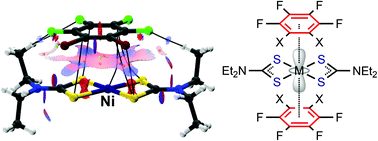Inorganic–organic {dz2-MIIS4}⋯π-hole stacking in reverse sandwich structures: the case of cocrystals of group 10 metal dithiocarbamates with electron-deficient arenes†
Abstract
Cocrystallization of the dithiocarbamate complexes [M(S2CNEt2)2] (M = Ni 1, Pd 2, Pt 3) and X-substituted perfluoroarenes (X = I, Br; 1,2-dibromoperfluorobenzene FBrB and 1,2-diiodoperfluorobenzene FIB) gives isomorphous cocrystals of (1–3)·2(FBrB) and 1·2(FIB), correspondingly, whose structures were studied by single-crystal X-ray diffractometry. The crystal structures demonstrate similar intermolecular contact types: short arene MS4⋯π-hole stacking contacts, X⋯S halogen bonds, C–H⋯X (X = Br, I) bonds and C–H⋯F hydrogen bonds. In these structures, the {dz2-MIIS4} moiety functions as an integrated five-center acceptor (that includes a metal dz2-orbital, even for a poorly dz2-nucleophilic NiII center) toward the π-hole of an X-substituted perfluoroarene. This interaction provides stacking of inorganic and organic units furnishing the reverse sandwich structures. Density functional theory (DFT) calculations, in combination with quantum theory of atoms-in-molecules (QTAIM) and noncovalent interaction plot (NCIplot) analyses, supported the structure-defining role of the {MS4}⋯π-hole contacts. The nucleophilicity of the {MS4} cores toward electron deficient π-holes was verified from the molecular electrostatic potential surface (MEP) and electron density/electrostatic potential (ED/ESP) profiles, and atoms-in-molecules (AIM) charge analysis. The relatively strong {MS4}⋯π-hole contact strength (interaction energies for an {MS4}⋯π-hole 1 : 1 adduct range from −12.1 to −13.5 kcal mol−1) is probably due to the large overlap between the electron deficient π-cloud and the integrated {MS4} nucleophilic core. The 1 : 1 adduct based on 3 demonstrates the largest strength (13.5 kcal mol−1) in the series and this strength agrees well with the higher dz2-nucleophilicity of the PtII center revealed by the MEP analysis (−33.6 kcal mol−1).



 Please wait while we load your content...
Please wait while we load your content...